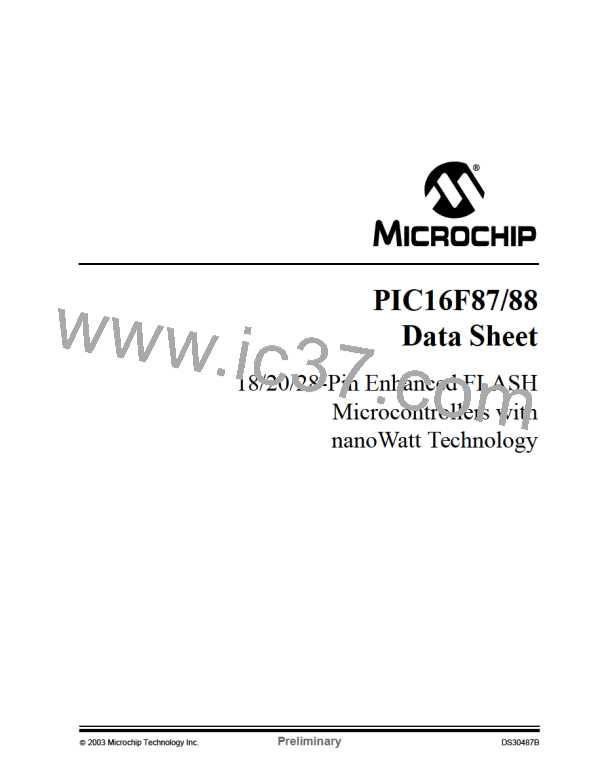PIC16F87/88
2. CONDITIONS:
15.12.4.2 FSCM and the Watchdog Timer
After a POR (Power-on Reset), the device is
running in Two-Speed Start-up mode. The crys-
tal fails before the OST has expired. If a crystal
fails during the OST period, a fail-safe condition
will not be detected (OSFIF will not get set).
When a clock failure is detected, SCS<1:0> will be
forced to ‘10’, which will reset the WDT (if enabled).
15.12.4.3 POR or Wake From Sleep
The FSCM is designed to detect oscillator failure at any
point after the device has exited Power-on Reset
(POR) or low-power SLEEP mode. When the primary
system clock is EC, RC or INTRC modes, monitoring
can begin immediately following these events.
OSTS = 0
SCS = 00
OSFIF = 0
USER ACTION:
For Oscillator modes involving a crystal or resonator
(HS, LP, or XT), the situation is somewhat different.
Since the oscillator may require a start-up time consid-
erably longer than the FSCM sample clock time, a false
clock failure may be detected. To prevent this, the inter-
nal oscillator block is automatically configured as the
system clock and functions until the primary clock is
stable (the OST timer has timed out). This is identical
to Two-Speed Start-up mode. Once the primary clock is
stable, the INTRC returns to its role as the FSCM
source.
Check the OSTS bit. If it’s clear and the OST
should have expired at this point, then the user
can assume the crystal has failed. The user
should change the SCS bit to cause a clock
switch which will also release the 10-bit ripple
counter for WDT operation (if enabled).
3. CONDITIONS:
The device is clocked from a crystal during
normal operation and it fails.
OSTS = 0
SCS = 00
OSFIF = 1
Note:
The same logic that prevents false oscilla-
tor failure interrupts on PORT or wake
from SLEEP, will also prevent the detec-
tion of the oscillator’s failure to start at all
following these events. This can be
avoided by monitoring the OSTS bit and
using a timing routine to determine if the
oscillator is taking too long to start. Even
so, no oscillator failure interrupt will be
flagged.
USER ACTION:
Clear the OSFIF bit. Configure the SCS bits for
a clock switch and the fail-safe condition will be
cleared. Later, if the user decides to, the crystal
can be re-tried for operation. If this is done, the
OSTS bit should be monitored to determine if
the crystal operates.
15.12.4.4 Example Fail-Safe Conditions
1. CONDITIONS:
15.13 Power-down Mode (SLEEP)
Power-down mode is entered by executing a SLEEP
instruction.
The device is clocked from a crystal, crystal
operation fails and then SLEEP mode is
entered.
If enabled, the Watchdog Timer will be cleared but
keeps running, the PD bit (STATUS<3>) is cleared, the
TO (STATUS<4>) bit is set, and the oscillator driver is
turned off. The I/O ports maintain the status they had
before the SLEEP instruction was executed (driving
high, low, or high-impedance).
OSTS = 0
SCS = 00
OSFIF = 1
USER ACTION:
For lowest current consumption in this mode, place all
I/O pins at either VDD or VSS, ensure no external cir-
cuitry is drawing current from the I/O pin, power-down
the A/D and disable external clocks. Pull all I/O pins
that are hi-impedance inputs, high or low externally, to
avoid switching currents caused by floating inputs. The
T0CKI input should also be at VDD or VSS for lowest
current consumption. The contribution from on-chip
pull-ups on PORTB should also be considered.
SLEEP mode will exit the fail-safe condition.
Therefore, if the user code did not handle the
detected fail-safe prior to the SLEEP command,
then upon wake-up, the device will try to start
the crystal that failed and a fail-safe condition
will not be detected. Monitoring the OSTS bit will
determine if the crystal is operating. The user
should not enter SLEEP mode without handling
the fail-safe condition first.
The MCLR pin must be at a logic high level (VIHMC).
2003 Microchip Technology Inc.
Preliminary
DS30487B-page 145

 MICROCHIP [ MICROCHIP ]
MICROCHIP [ MICROCHIP ]